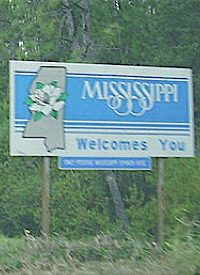
“Mississippi is the most religious U.S. state, and is one of eight states where Gallup classifies at least half of the residents as ‘very religious,’” wrote Gallup’s Frank Newport of the latest survey. “At the other end of the spectrum,” he noted, “Vermont and New Hampshire are the least religious states, and are two of the five states — along with Maine, Massachusetts, and Alaska — where less than 30% of all residents are very religious.” Also in the mix of least religious are the Pacific coast states of Oregon and Washington, which matched Nevada with only 30 percent of the population claiming any religious fervor.
The survey, based on Gallup interviews with 350,000 adults during 2011, asked respondents if religion is an important part of their daily life, and if they attend religious services every week or almost every week.
After Mississippi, which led all states with 59 percent of its citizens identifying themselves as very religious, came Utah (57 percent), Alabama (56), Louisiana (54), Arkansas (54), South Carolina (54), Tennessee (52), North Carolina (50), Georgia (48), and Oklahoma (48).
On the flip side, the far more secular states of Vermont and New Hampshire each claimed a mere 23 percent of “very religious” residents, followed by Maine (25 percent), Massachusetts (28), Alaska (28), Oregon (30), Nevada (30), Washington (30), Connecticut (31), District of Columbia (32), New York (32), and Rhode Island (32).
Overall Gallup classified 40 percent of Americans as very religious, “based on their statement that religion is an important part of their daily life and that they attend religious services every week or almost every week,” explained Newport. By contrast, about 32 percent of Americans would be classified as nonreligious, “based on their statement that religion is not an important part of their daily life and that they seldom or never attend religious services.”
Newport added that the “remaining 28% of Americans are moderately religious, because they say religion is important but that they do not attend services regularly or because they say religion is not important but still attend services.”
As Gallup has found in its surveys in recent years, “America remains a generally religious nation, with more than two-thirds of the nation’s residents classified as very or moderately religious,” wrote Newport. However, he added, the national averages “reveal dramatic regional differences,” where either religious or secular emphasis can influence both political and cultural trends.
“Religion is related to politics in today’s America,” wrote Newport, “and it is clear from a glance at Gallup’s State of the States map that the most religious states in the union generally are the most Republican, while the least religious states skew more toward the Democratic Party.”
What that boils down to is that the most politically divided states “are the ones where residents tend to be neither at the very religious nor at the nonreligious end of the spectrum,” wrote Newport.
In terms of presidential politics and important cultural issues such as abortion and same-sex marriage, these states mark “undecided” regions that could serve to swing the nation in either a more liberal or conservative direction, based on the amount of lobbying and campaigning they receive from candidates or groups representing a particular position.
As in past Gallup religion surveys, the only major anomaly in the demographic makeup of this year’s poll was Utah, a perennial “very religious” island in a sea of moderately faithful to downright unreligious also-rans. While many Americans might guess that the Beehive State, with its deeply Mormon foundation and influence, would rank as the most religious state in the union, Robert Kirby of the Salt Lake Tribune pondered why his state ended up running a razor-thin second to number-one Mississippi.
“Exactly how Mississippi accomplished this religious coup without its legislature being dominated by a single faith, school seminary programs, or smothering liquor laws is anybody’s guess,” Kirby wrote.
After a closer examination of the two cultures, however, he began to notice some subtle distinctions that could have served to inch the Magnolia State ahead. “For example,” he observed, while Mormons shun the use of alcohol, one can, nonetheless, “buy alcohol in each of Utah’s 29 counties. You have to jump through some annoying hoops, but the point is you can get it. Conversely, nearly half of Mississippi’s 82 counties are dry.” Chalk that up to Mississippi’s own conservative Baptist bona fides.
As for one of the Mormon faith’s most notable distinctives — shunning caffeine — Kirby observed somewhat tongue-in-cheek: “Despite Utah’s large Mormon population, we’re not really sticking to the Word of Wisdom as well as we might. Mississippi ranks 49th in the number of Starbucks per state. Utah is 25th.”
But on a note that faithful LDS members ought to find troubling, Kirby pointed out that according to “one gay and lesbian travel website, Salt Lake City ranks No. 5 on a list of most underrated gay-friendly cities in America.” By contrast, he wrote, “Mississippi doesn’t even show up on a Google search using the words “gay friendly.’”

